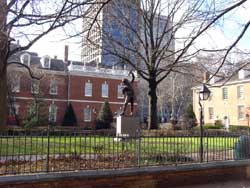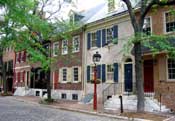Philadelphia Travel Review

Philadelphia History
When William Penn landed in 1682, he found a primitive village with colonist living in log huts and caves along the Delaware River. Warned to arm himself against the savage Lenape Indians, Penn chose instead another approach - "The Indians... have been killed and robbed by the settlers. Let us now try what Love will do." This new attitude led to Philadelphia's current motto - City of Brotherly Love and the famous Love statue in Love park. In 1723, Ben Franklin arrived with only pennies in his pocket. By 1774, Franklin and his associates helped make Philadelphia the city of many American firsts - fire company, lending library, hospital, medical school, police force, paved streets and lighting and insurance company. Philadelphia was a manufacturing center for steamships, streetcars, locomotives, textiles, cigars and hats (famous Stetson hat made here). It was the nation's political capital until 1880 and the nerve center of colonial communications.
In 1723, Ben Franklin arrived with only pennies in his pocket. By 1774, Franklin and his associates helped make Philadelphia the city of many American firsts - fire company, lending library, hospital, medical school, police force, paved streets and lighting and insurance company. Philadelphia was a manufacturing center for steamships, streetcars, locomotives, textiles, cigars and hats (famous Stetson hat made here). It was the nation's political capital until 1880 and the nerve center of colonial communications.
The signing of the Declaration of Independence in Philadelphia's Independence Hall on 1776 was not widely recognized at the time for the far-reaching implications it would have not only for the former thirteen colonies, but also for countries around the world where people wished to freely conduct their business and live their lives with only limited interference from a central government. The concept that a government derived its power from the people it governed was a truly novel idea which had only been discussed by philosophers and social critics- never in widespread practice and certainly not seriously considered by the reigning monarchs of the period. Yet democracy- the idea that a people could govern themselves, set their own rules, vote for their own representatives to enact their own laws for human behavior- became a blueprint for the foundation of modern capitalist society. The fundamental rules and laws set forth then
are largely intact today- and they have allowed great cities to grow and flourish- and Philadelphia is one of them.
Philadelphia's architectural development was restrained until 1990 because new buildings could not be taller than William Penn's statue on City Hall. Now the city combines both historic sections with the new to create a vibrant and easily walkable downtown. More Philadelphia history
Philadelphia Attractions
The Philadelphia Art Museum, with its towering Greek Revival columns and the famous steps where Rocky (Sylvester Stallone) ran up to proclaim his strength and vitality is a great place to visit for anyone who loves painting, sculpture, pottery and a huge variety of artifacts from the Greeks and Romans, up through the Middle Ages and the present. The Atwater-Kent Museum has a rich archive of Americana, including paintings by Norman Rockwell, along with many of his famous covers for the Saturday Evening Post. The Rodin Museum down the street from the Philadelphia Art Museum has an huge display of sculptures by this famous Impressionist artist.
The world famous Franklin Institute (with the walk-through human heart and the Spirit of St. Louis airplane) has a wide range of scientific exhibits which should thrill those interested in chemistry, geology, physics, electricity, weather, medicine and other topics. The lights illuminating Boathouse Row along West River Drive shine at night as a symbol of the rich intellectual tradition of the region, as these crew houses of famous schools such as the University of Pennsylvania, Drexel University, Temple University and many others showcase the talent of young athletes ready to compete. Benjamin Franklin was a strong proponent of active intellectual debate and was the founder of the American Theosophical Society; this allowed a rich culture of intellectual pursuit to grow. On the lighterside, Philadelphia is also home to the Mummers Parade.
Fairmount Park- the largest city park in the United States- offers walking trails, park benches to relax and spots to picnic with family and friends. The Philadelphia Zoo is not only a great place for children- it has one of the largest varieties of animals of any zoo in the country. City Hall downtown is one of the most magnificent examples of Neoclassical architecture and design on the East Coast (tours are given daily). Atop the monstrous structure, with its numerous surrounding sculptures and monuments- is a statue of William Penn, the man who made it all possible. Liberty One and Liberty Two are the tallest buildings in downtown Philadelphia, both resembling the iconic Chrysler Building in New York. At the base of Liberty One is a huge shopping complex with restaurants and related establishments. More Philadelphia attractions...
